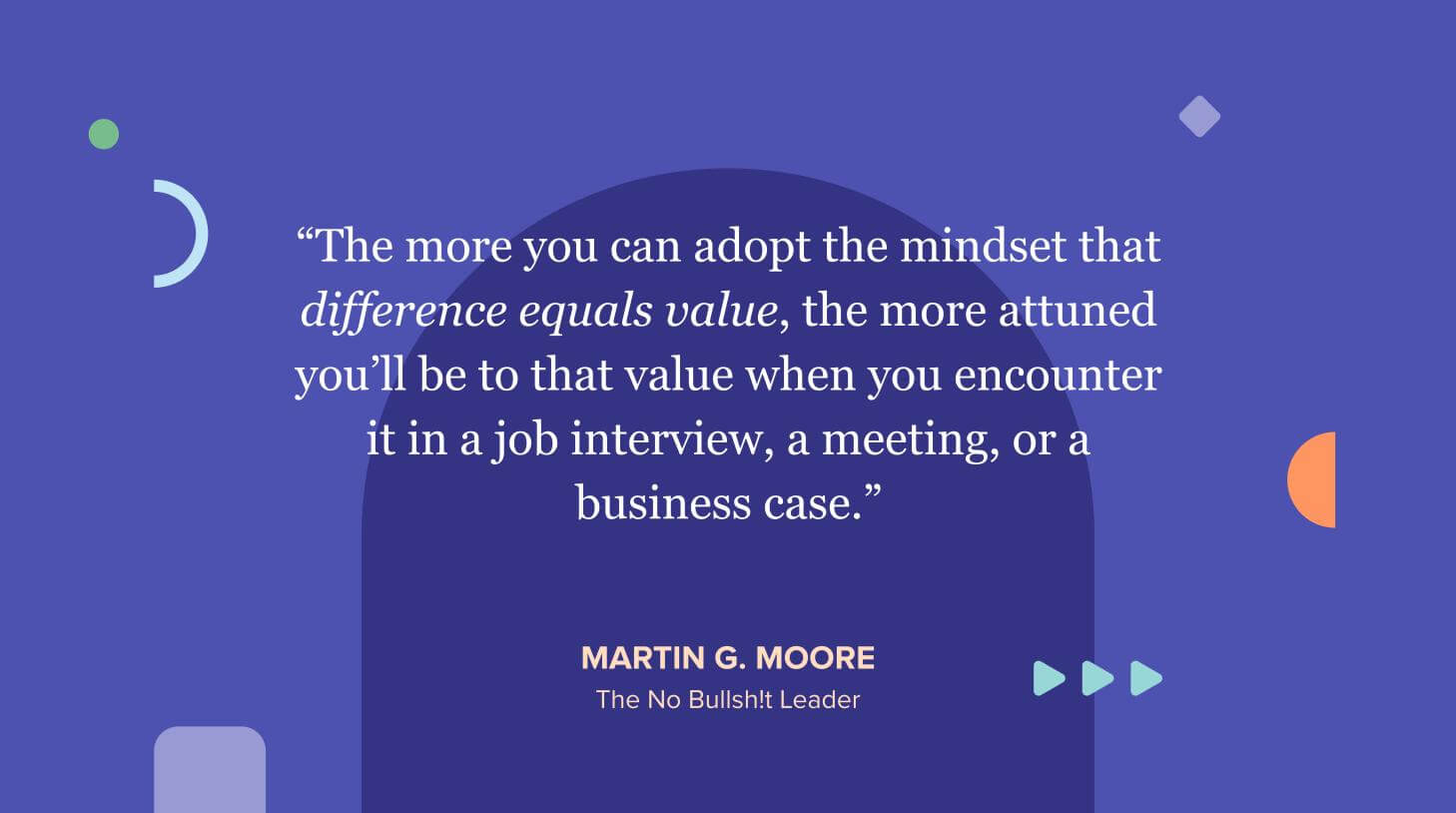Diversity on its own isn’t enough: 6 tips to leverage value
Leveraging diversity involves more than just checking off a 'diversity' box. It requires creating an environment that encourages robust debate and values differing perspectives. This can be achieved through strategies such as not speaking first as a leader, listening objectively, and drawing in quieter team members.

Despite our best intentions, we do have natural barriers to building diverse teams. Our affinity bias leads us to hire people in our own image, which serves only to confirm our existing perspectives, rather than explore new ones.
The needle of diversity is moving too slowly. Perhaps change can be accelerated by showing how diversity can drive extraordinary value. It’s now about determining how to unlock it.
Diversity is more than gender
The dominant focal points for diversity are gender and ethnicity. The deficit in these dimensions is obvious in most organizations, as they’re relatively easy to measure. They’re also well informed by moral, ethical, and social drivers, as much as anything else.
When you consider organizational performance, there is a range of categories you can add to gender and ethnicity that provide an even greater opportunity for unlocking value. Differing perspectives are shaped by people’s sexual orientation, their age, their immigrant status, the industries they’ve worked in, the physical locations they’re in, and even the size of the organizations they’ve been part of. The list goes on.
The more you can adopt the mindset that difference equals value, the more attuned you’ll be to that value when you encounter it in a job interview, a meeting, or a business case.
What’s the point of having a highly diverse team if you can’t draw out the unique experiences, capabilities, and perspectives of each of your people? The challenge for every leader is to create an environment where people feel safe to contribute, to challenge each other, and to debate issues with a view to getting the best outcome – and not simply pushing your own opinions.
Competing against this ideal are two things: our natural tendency to avoid conflict, and our fear of being wrong. But high-performing teams aren’t built on unanimity and consensus. They are built on robust debate, respectful challenge, and fearless honesty.
Six tips for leveraging diversity
Leveraging diversity is most important in two scenarios:
- When you’re solving a complex problem.
- When you’re making a difficult decision.
These are the points at which you want as much diversity of input as possible. It will help you to avoid groupthink, and consider factors that may not have been identified by a less diverse group.
As most of this type of work occurs in group settings, these six practical tips on leveraging diversity will help you to maximize the opportunities when they present themselves.
1. Qualify the room
Only people who can add value to a decision or problem should be in the room, and this is usually fewer people than you think (or they think). People love having input in an all care, no responsibility way, but that’s not constructive. It slows the process down and adds little value to the outcome.
Get the right people in the room, give them all the information they need to fully contribute to the topic, and create an environment where it’s easy for them to express their views.
2. Don’t speak first
As a leader, it’s important to empower and encourage people to contribute before they have the benefit of knowing your position. Only the most resilient and robust individuals will contradict or offer alternatives to a strong leader, once that leader has shown her hand.
Facilitating the conversation to draw out people’s views and incorporate them into the framework of the discussion will do a lot to unlock diversity, so you don’t want to stymie that in any way.
3. Listen objectively
Listening is a much underrated skill, but one that’s critical to fostering diversity. We naturally tend to discard any information that doesn’t conform to our own world view.
Putting aside your own preferences and viewpoints, and asking yourself a few simple questions will improve your listening skills:
- What can I learn from this?
- What am I hearing that I hadn’t considered previously?
- How can this perspective improve our current position?
When you open yourself to the input of others, you’ll pick up some valuable insights that can only add to the existing conversation.
4. Draw in the quiet ones
Many people don’t like to talk in group forums. They need to learn to, and as a leader you need to teach them how. Although it might be safer and less confrontational to send an email to express their views, people only bring true value when they allow their ideas to be challenged.
When moderating group discussions, call on these people by name. Support them, and show them that their perspectives are valued, and that it’s safe for them to contribute.
5. Show a willingness to shift
When something changes your mind, or improves your understanding of an issue, be explicit about the fact that you’re changing your mind based on their input. This will encourage people to contribute in the future. If you don’t constantly demonstrate a willingness to be convinced of an opinion other than your own, people will stop offering theirs.
Once people can see that their ideas can make a real difference, they’ll be more likely to offer them up. Over time, this will become a key motivator for your people.
6. Encourage robust debate
Respectful, robust debate is the means by which alternative viewpoints are uncovered and challenged. Help your people to become more confident by rewarding them for engaging in this way.
Public praise and one-on-one reinforcement can motivate someone to up the ante in their contribution, because they understand why it’s important and they’re prepared to take a little personal risk to see that unfold.
Without robust debate of alternative viewpoints, people’s input is only of marginal value.
Make performance through diversity your brand
Your ability to liberate people’s talent and experience is the real key to unlocking and leveraging diversity. Ultimately, this becomes a true driver of performance, and a defining characteristic of your team. Results speak louder than anything else, so if you learn to harness the power of diversity to drive better results, people will sit up and pay attention.
Once this becomes part of your culture, it forms an important plank in your employee value proposition. Why would people want to work for you? Because you value diversity in a way that takes the organization to new levels of performance – it’s your brand, after all.
Who wouldn’t want to work in a company like that?
Martin G. Moore is the former CEO of CS Energy. Within five years, he grew earnings from $17 million to $441 million, a compound annual growth rate of 125%. Moore hosts the chart-topping No Bullsh!t Leadership podcast, and his book, No Bullsh!t Leadership, is scheduled to be published in August 2021.
Frequently asked questions
- What does diversity mean beyond gender and ethnicity?
- Diversity extends beyond gender and ethnicity. It includes a range of categories such as sexual orientation, age, immigrant status, industries worked in, physical locations, and the size of organizations individuals have been part of. The more diverse the perspectives, the greater the opportunity for unlocking value.
- Why is constructive tension crucial in a diverse team?
- Constructive tension is essential in a diverse team to draw out unique experiences, capabilities, and perspectives. High-performing teams are built on robust debate, respectful challenge, and fearless honesty, not on unanimity and consensus.
- What are some tips for leveraging diversity?
- Tips for leveraging diversity include qualifying the room, not speaking first as a leader, listening objectively, drawing in the quiet ones, showing a willingness to shift, and encouraging robust debate. These strategies help to maximize diversity of input, especially when solving complex problems or making difficult decisions.
- How can leaders encourage quiet individuals to contribute?
- Leaders can encourage quiet individuals to contribute by calling on them by name during group discussions, supporting them, and showing them that their perspectives are valued. This creates a safe environment for them to express their views.
- How can diversity become a part of a company's brand?
- By liberating people's talent and experience, diversity can become a true driver of performance and a defining characteristic of a team. Once this becomes part of a company's culture, it forms an important part of the employee value proposition, making the company more attractive to potential employees.





